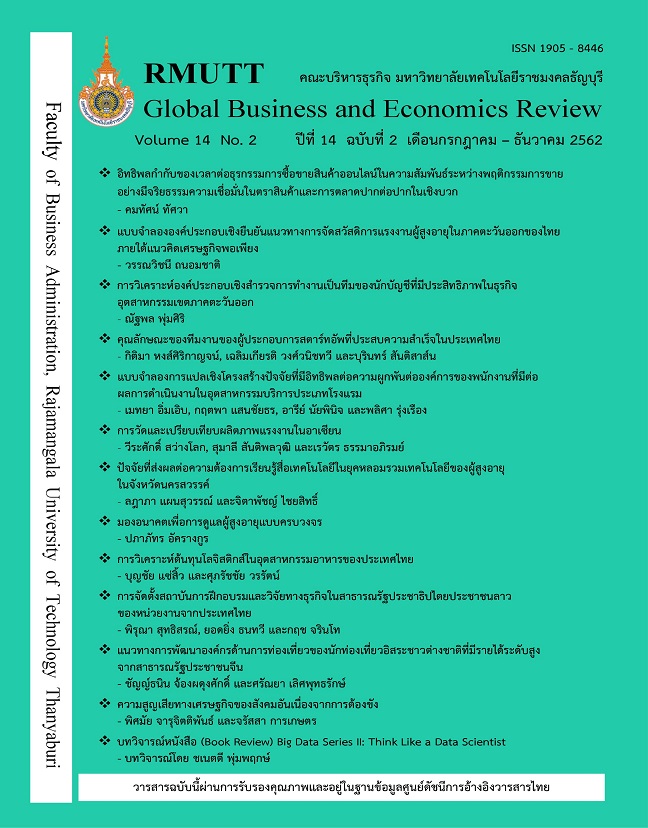GUIDELINES FOR TOURISM ORGANIZATION IMPROVEMENT FOR HIGH-INCOME INDEPENDENT TOURISTS FROM REPUBLIC OF CHINA
Keywords:
Tourism Development, FIT Tourists, The People's Republic of ChinaAbstract
The purposes of this research are to study the promotional tourism policies, roles of organizations related to tourism development, tourists' preferences, tourism services, and the suggestions from owners of tour companies and tour leaders toward tourism development for FIT tourists from the People's Republic of China. Qualitative research was used in the study with semi-structured questions used for in-depth interviews. The key informants consisted of 18 executive directors/mangers and tour leaders from both government and private organizations which responsible for providing services to tourists from Republic of China. The research found that guidelines of tourism development for FIT tourists from the People's Republic of China were: government organizations should focus on solving security problems, increase supervision of the private sector in improving transportation standards, develop visa system, establish a system to monitor and track illegal tour companies, promote tax returns, create new tourist attractions, food quality and price inspections as well as improve the cleanliness of tourist attractions, restaurant, toilets. While the private sector should increase the quality of service by improving Chinese language skills for their staff, create online media or application to serve tourists instead of let tourists used applications in China. Allowing tourists to book tour leaders and accommodation through the application of Thailand. The government organizations and private companies should work together to promote Thai tourism.
References
กระทรวงการท่องเที่ยวและกีฬา. (2561). สถิติด้านการท่องเที่ยวปี 2561 สถิติผู้เดินทางเข้า-ออกราชอาณาจักร 5 ท่าอากาศยาน. สืบค้นจากhttps://www.mots.go.th/more_news.php?cid=500&filename=index
บุญเลิศ จิตตั้งวัฒนา. (2548). อุตสาหกรรมการท่องเที่ยว. กรุงเทพฯ: เพรส แอนด์ ดีไซน์.
แบรนด์บุฟเฟ่ต์. (2560). เจาะลึกทุกมุม นักท่องเที่ยวจีนสไตล์ FIT โอกาสมหาศาลของแบรนด์ไทยที่ไม่ควรมองข้าม. สืบค้นจาก https://www.brandbuffet.in.th/2017/05/chinese-tourist-trends-and-opportunities-for-thai-brand/
ประชาชาติธุรกิจ. (2019). บริษัททัวร์ เร่งปรับตัว รับเทรนด์นักท่องเที่ยวกลุ่ม FIT โตแรง. สืบค้นจาก https://www.prachachat.net/tourism/news-288676
มติชนออนไลน์. (2559). ถึงเวลาเช็คบิล นอมินี ต่างชาติกอบโกยธุรกิจทัวร์. สืบค้นจาก https://www.matichon.co.th/politics/news_204407
มิ่งสรรพ์ ขาวสะอาด, อัครพงศ์ อั้นทอง, กรวรรณ สังขกร และสุเมธ พฤกษ์ฤดี. (2553) แผนงานวิจัยการพัฒนาเชิงบูรณาการของการท่องเที่ยวที่ยั่งยืนในอนุภูมิภาคลุ่มแม่น้ำโขง ปี 2551: ตลาดใหม่และความท้าทาย. เชียงใหม่: สถาบันศึกษานโยบายสาธารณะ สถาบันวิจัยสังคม มหาวิทยาลัยเชียงใหม่.
วุฒิ สุขเจริญ. (2558). แนวทางการออกแบบรายการท่องเที่ยวสำหรับนักท่องเที่ยวชาวจีนโดยใช้เทคนิคการวิเคราะห์องค์ประกอบร่วม. วารสารปัญญาภิวัฒน์, 7(ฉบับพิเศษ), 52-62.
วีรศักดิ์ เกิดผลเจริญยิ่ง. (2556). นักท่องเที่ยวจีนยุคใหม่กับกระแสการท่องเที่ยวด้วยตนเอง. สืบค้นจาก https://www.thaibizchina.com
ศูนย์วิจัยกสิกรไทย. (2561). เทรนด์ท่องเที่ยวดี SME รีบคว้าโอกาส. สืบค้นจาก https://kasikornbank.com/th/business/sme/KSMEKnowledge/article/KSMEAnalysis/Documents/Tourism-trend_SME-Opportunity.pdf
สำนักงานคลังจังหวัดภูเก็ต (2562). รายงานประมาณการเศรษฐกิจจังหวัดภูเก็ต. สืบค้นจาก https://www.cgd.go.th/pkt
สำนักงานปลัดกระทรวงการท่องเที่ยวและกีฬา. (2560ก). รายงานสถิติการท่องเที่ยวประเทศไทยประจำปี พ.ศ. 2560. สืบค้นจาก https://www.mots.go.th/ewt_dl_link.php?nid=11588
สำนักงานปลัดกระทรวงการท่องเที่ยวและกีฬา. (2560ข). แผนพัฒนาการท่องเที่ยวแห่งชาติฉบับที่ 2 พ.ศ. 2560-2564. กรุงเทพฯ: สำนักงานกิจการโรงพิมพ์องค์การสงเคราะห์ทหารผ่านศึก.
อัครพงศ์ อั้นทอง. (2561). การจำแนกคุณลักษณะของการท่องเที่ยวเชียงใหม่ตามโครงสร้างความพึงพอใจของนักท่องเที่ยวชาวจีนกลุ่มอิสระ. วารสารเศรษฐศาสตร์ประยุกต์, 25(2), 35-54.
อระนุช โกศล และโชคชัย สุทธาเวศ. (2557). การจัดการด้านการท่องเที่ยวอย่างยั่งยืนเพื่อรองรับการเข้าสู่ประชาคมเศรษฐกิจอาเชียน. วารสารการเมืองการปกครอง, 4(1), 220-232.
China Power Team. (2019). How Well-off is China’s Middle Class?. Retrieved from https://chinapower.csis.org/china-middle-class/
Hughes, K., Wang, J., & Shu, M. (2015). Exploring the travel patterns, preferences and Recommendations of Chinese university students living in Australia. Journal of Hospitality and Tourism Management, 23, 12-22.
Rovinelli, R. J., & Hambleton, R. K. (1977). On the use of content specialists in the assessment of criterion-referenced test item validity. Dutch Journal of Educational Research, 2, 49-60.
Wu, M.-Y., & Pearce, P. L. (2013). Chinese recreational vehicle tourists in Australia. Retrieved Jan 26, 2015, from https://www.savannahway.com.au/resources/jcucn2013.pdf
Zhang, Y., & Cai, L. (2017). Land, family, and Chinese-ness: The influence of Chinese values on the study of tourism. Tourism Culture & Communication, 17(4), 249-257.
Downloads
Published
How to Cite
Issue
Section
License
The articles published in this journal are the intellectual property of their respective authors.
The views and opinions expressed in each article are solely those of the individual authors and do not reflect the positions of Rajamangala University of Technology Thanyaburi or any of its faculty members. All components and content of each article are the sole responsibility of the respective authors. In the event of any errors, the authors shall bear full responsibility for their own work.








